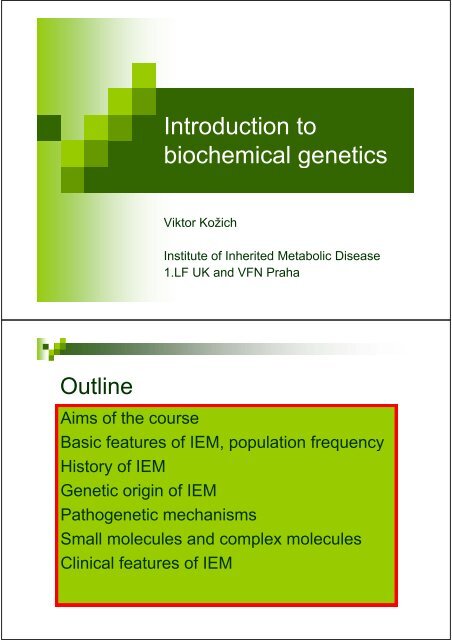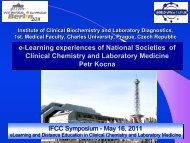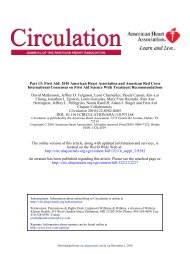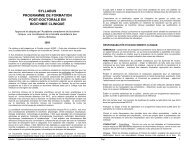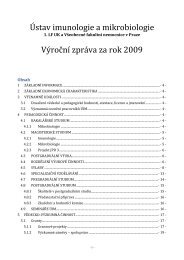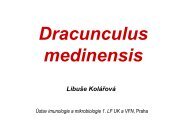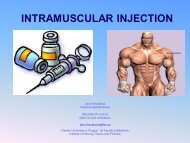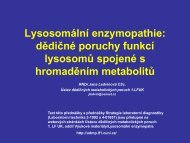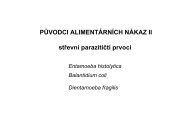Introduction to Introduction to biochemical genetics
Introduction to Introduction to biochemical genetics
Introduction to Introduction to biochemical genetics
- No tags were found...
Create successful ePaper yourself
Turn your PDF publications into a flip-book with our unique Google optimized e-Paper software.
Case 3- MPS Ihttp://eyepathologist.com/images/KL1771.jpghttp://deti.msk.ru/plaxin_egor.jpghttp://myweb.lsbu.ac.uk/dirt/museum/margaret/438-1811-2640151.jpgCase 4-cystinuriahttp://www.nature.com/ki/journal/v73/n8/images/5002790f1.jpghttp://graphics8.nytimes.com/images/2007/08/01/health/adam/17046.jpg
His<strong>to</strong>ry of <strong>biochemical</strong><strong>genetics</strong>1857-1936http://www.his<strong>to</strong>riadelamedicina.org/imagenes/garrod.jpg
Trophîme Bigot, 16.-17.s<strong>to</strong>letíhttp://www.the<strong>to</strong>que.com/010605/pics/urine.jpghttp://images.google.com/imgres?imgurl=http://upload.wikimedia.org/wikipedia/commons/thumb/8/8c/Bigot,_Trophime_-_A_Doc<strong>to</strong>r_Examining_Urine.jpg/• 1857 L.Pasteur demonstrates microbial origin offermentation, R.Wirchow describes mi<strong>to</strong>sis• 1867 dynamit• 1874 jeans• 1886 au<strong>to</strong>mobil=car• 1890 underground• 1895 cinema<strong>to</strong>graf• 1902 periskop, el.typewriter; Nobel prize fordiscovery of malaria transmission• 1908 Nobel prize for discovery of immunity• 1936 tape recored; Nobel prize forneurotransmitter research
Lancet, vol ii, 1902, 1616-1620
Expansion of the field1908• 5 diseases(alkap<strong>to</strong>nuria,cystinuria, porphyria,pen<strong>to</strong>suria, congenitalstea<strong>to</strong>rhea)•1909 first textbook•incidence unknown•dx: 4 metabolites inurine•Rx nonecca 1960• ca 40-50diseases•analyticalmethods•incidence of PKU•PKU- 1stscreening program(R.Guthrie)•PKU-1st treatableIEM (H.Bickel)2009•at least 500 diseases•Medline 122.797papers (28/9/2009)•textbook-web tb bbased•incidence at least1:1.000•Dx: metabolites,enzymes, DNA•screening MS-MS•Rx for ~ 1/3 diseasesBiochemical <strong>genetics</strong> in the ČR• PKU screening 1975-Doc.Blehová, Prof.Hyánek,Ing.Mrskoš• Dx of other IEMs-leader Prof.Hyánek• labs in Prague, H.Králové, Brno, Olomouc,Ostrava• in 2009: selective screening ~ 100 pacientů/rok (incidence1:1000) newborn screening- 10 IEMs since Oc<strong>to</strong>ber 1 2009,expected incidence 1:4000
First IEM:Alkap<strong>to</strong>nuriahttp://bjo.bmj.com/content/vol83/issue6/images/large/98532.f1.jpeghttp://www.scielo.br/img/revistas/rbr/v46n5/a14fig02.jpghttp://www.mja.com.au/public/issues/184_12_190606/sha20286_fm-1b.jpg
1859 Boedeker- alkap<strong>to</strong>n in urine1891 alkap<strong>to</strong>n=homogentisic acid
http://www.bioinformatics.nl/webportal/background/images/mendelexperiment.gifGarrodův revolutionary concept• Chemical individuality is determined bygenes• Inborn errors of metabolism= disturbanceof chemical individuality
Alkap<strong>to</strong>nuria in 2009• retrospective reasearch ofmummy HARWA 1500 př.n.l.• pateints known before Garrod• 1902 Garrod• 1909 tyrosine degradationpathway described• 1958 enzyme defect inalkap<strong>to</strong>nuria established• 1996 HGO gene description• 2003 treatment with nitisoneCoxarthrosisValvularinvolvementUrolithiasishttp://bjo.bmj.com/content/vol83/issue6/images/large/98532.f1.jpeghttp://www.scielo.br/img/revistas/rbr/v46n5/a14fig02.jpghttp://www.mja.com.au/public/issues/184_12_190606/sha20286_fm-1b.jpg
http://www.natuurlijkerwijs.com/english/b4f4ca00.gif• Liver HGOdeficiency• Incidence 1:250000 až 1:11 000 000• High incidenceSlovakia• Late complicationsfrequent• Rx inefficienthttp://ourworld.compuserve.com/homepages/sbrillanti/liver2.jpg
http://en.wikipedia.org/wiki/Novel treatment in alkap<strong>to</strong>nurianitison (NTBC)http://www.natuurlijkerwijs.com/english/b4f4ca00.gif
Genetic origin of IEMs
Genetic origin of IEM• Monogenic Mendelian inheritance AR inheritance GR/GD inheritance rarely AD inheritanceX• Mi<strong>to</strong>chondrial inheritance• Epigenetic changes• X-inactivation• Epsistasis• Gene x environment interaction• otherCommon types of mutations
Molecular consequences of mutations• Protein amounts decreased same increased• Protein properties changes of isolated functions global changes misfolding• Nonprotein gene products siRNARole of mutations in evolution• Source of variability(less important thanmeiotic recombinationand combination ofgametes)• Favourable mutationsare rare and alreadycontained in genomes• Genetic diseases= tip of• Genetic diseases tip oficeberg (of geneticvariability)
Mutations affect different domains• e.g. PAH• cy<strong>to</strong>solic enzyme• homotetramer• BH4 as cofak<strong>to</strong>r• complicatedmechanism ofcatalysisErlandsen H and Stevens RC, The Structural Basis of Phenylke<strong>to</strong>nuria. Mol Genet Metab. 1999 Oct; 68(2):103-125.Cellular consequences ofmutations (e.g.CFTR)http://student.biology.arizona.edu/honors97/group7/Hallick1.gif
Genotype-phenotype (M.Gaucher)Phenotypeseveresplenomegalyanemiabone disorderCNSmildsplenomegalyanemiaunclearhttp://www.nature.com/embor/journal/v4/n7/thumbs/embor873-f4.gifHealth-disease thresholdclinical manifestationenvironmentgenespreclinical testgenetic test
IEM treatment- modifying environmentclinical manifestationenvironmentgenespreclinical testgenetic testGene x environment interaction (PKU)http://www.pkunews.org/adults/image005.gif
Disease modification byenvironment (alpha1-antitrypsin)Current <strong>genetics</strong> is notMendelianclassical <strong>genetics</strong>1 gene=1 disease• 1 gene = more diseases• 1 gene = diseases withdifferent types of inheritance• several genes = same disease• digenic inheritance• transgenerationaltransmission of epigeneticmarks• other ……
Genetics has been and will be full of suprisesPa<strong>to</strong>physiologicalmechanisms in IEMs
Pa<strong>to</strong>physiologyprecursorsubstratebyproductenzymetransporterproductPa<strong>to</strong>physiologyprecursorsubstratebyproductExamples:• Phe a Phe-derivatives• ammonia• cystine in cystinosis• cystine in cystinuria• mucopolysaccharides
Pa<strong>to</strong>physiologyExamples:• glucose in GSD• ke<strong>to</strong>ne bodies in betaoxidationdefects• plasmalogens inperoxisom.diseases• cysteine in CBS deficiency• AdoMet in RM• ATP in mi<strong>to</strong>chondrialdiseasesproductLocal vs. systemic consequencesLocal consequence, e.g.:• MPS-bones, tendons, spleen, liver,CNS• cystinuria-urinary urinary tract
Local vs. systemic consequencesDistant consequences-e.g.• urea cycle disorders- coma• organic acidurias-encephalopathy• CBS deficiency- thrombosis, connectivetissue disturbancessubstrátproduktDisorders of small andcomplex molecules
Small molecules in <strong>biochemical</strong><strong>genetics</strong>• definition: < 1500 Da• gases, inorganic ions• amino acids• organic acids• saccharides• polyols• simple lipids• purines, pyrimidinesidi• vitamins• oligomers: peptides up <strong>to</strong> 5-10 AA, oligosaccharides• cy<strong>to</strong>sol, mi<strong>to</strong>chondrial stroma• blood, urineDiseases of small molecules• usually dependent on exogenous supply• manifestation: (repeated) acute <strong>to</strong>xicity, usuallywith encephalopathy/coma• hepa<strong>to</strong>pathy common• common disturbances in routine labs-ammonia,Astrup, ke<strong>to</strong>ne bodies, glycemia, uric acid...• symp<strong>to</strong>ms develop due <strong>to</strong> specific type of food,fasting, catabolism• chronic course possible (if <strong>to</strong>xicity low)• usually good therapeutic response <strong>to</strong> diet and/orvitaminsi
Isovaleric aciduria• FTT, vomiting, Kussmaulbreathing• consciousness: comawithin 24-48 h after onse<strong>to</strong>f symp<strong>to</strong>ms• metabolic acidosis,ke<strong>to</strong>nuria• sweaty feet syndromehttp://images.google.com/imgres?imgurl=http://upload.wikimedia.org/wikipedia/commons/8/8b/Isovaleric_acid_structure.pngCystinuriahttp://www.nature.com/ki/journal/v73/n8/images/5002790f1.jpghttp://graphics8.nytimes.com/images/2007/08/01/health/adam/17046.jpg
Complex molecules in <strong>biochemical</strong><strong>genetics</strong>• definition: > 1500 Da• glykolipids• sphingolipids• plasmalogens• neutral polysaccharides (glycogen)• mucopolysaccharides• (other polymers: proteins, nucleic acids...)• usually associated with membranes• concentrations in blood/urine rather low,exceptions exist ( x MS/MS technologie)Diseases of complex molecules• disease progresses usually regardless of anyexogenous sources from food• typical course is progressive (± symp<strong>to</strong>m-freeperiod)• dysmorphy at birth possible• frequent involvement of nervous system andmusculature• organomegaly due <strong>to</strong> s<strong>to</strong>rage in lysosomals<strong>to</strong>rage disorders• usually untreatable by diet or vitamins
Mukopolysaccharidosis type Ihttp://eyepathologist.com/images/KL1771.jpghttp://deti.msk.ru/plaxin_egor.jpghttp://myweb.lsbu.ac.uk/dirt/museum/margaret/438-1811-2640151.jpg< 1500 Da > 1500 DaAcute <strong>to</strong>xicity Y NChronic progression ± YLocalization cy<strong>to</strong>sol, ECT membranesImpact on structure N YDx blood,urine tissues (U)Origin exogenous endogenousRx-diet, vitamins efficious inefficious
Pa<strong>to</strong>physiology IEMsubstrate1500 Daproduct1 23Clinical manifestation ofIEMs
Clinical picture-agehttp://www.hrr.co.uk/acatalog/crocodile_<strong>to</strong>ddler.jpghttp://www.co.shasta.ca.us/html/DSS/images/FosterParentingAdopt/infant.jpghttp://markandrich.googlepages.com/Old-woman.jpg/Old-woman-full.jpgClinical features-organshttp://universe-review.ca/I10-82-organs.jpg
Selected common situations withhigh risk of IEM• Small molecules acutelly ill newborn (repeated) atack of long-term uncosciousness failure <strong>to</strong> thrive• Complex molecules progressive CNS and musculature involvement facial dysmorphy organomegaly (liver, spleen, heart)Food and IEMs (small molecules)• (sub)acute <strong>to</strong>xicitymilk (lac<strong>to</strong>se)-hepa<strong>to</strong>pathysaccharose/fruc<strong>to</strong>se/sorbi<strong>to</strong>l- hepa<strong>to</strong>pathyand hypoglycemiaexcess protein- vomiting, lethargy, coma(urea cycle disorders, organic acidurias)
Fasting and IEMs• hypoglycemia in GSD• hypoglycemia with decreased production ofke<strong>to</strong>ne bodies (beta-oxidation defects)• acidosis, ke<strong>to</strong>nuria and metabolicencephalopathy p in prolonged fasting (organicacidurias)• respira<strong>to</strong>ry alkalosis and encephalopathy (ureacycle disorders)Abnormal urinary smell and color• smell (small volatile molecules):• color• sweaty feet-isovalerate• maple syrup-branched ke<strong>to</strong>acids• boiled cabbage-methionine oxid• fish-trimethylamine• blackcurrant- organic acids• mouse-phenylacetate• orange-urate• black upon oxidation-homogentisate• blue-indoxyl derivaties• green-4-OH-butyrate
Common labs in IEMsBlood• glycemia• cholesterol• TG• uric acid• MAc• hyperammonemia, RAlk• ALT,AST• CK• anemia/pancy<strong>to</strong>peniaUrine• ke<strong>to</strong>ne bodies• uric acid• crystaluria• myoglobinuria1857-1936http://www.his<strong>to</strong>riadelamedicina.org/imagenes/garrod.jpg


